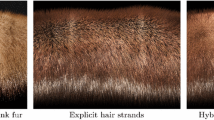Abstract
Generation of photo-realistic images of human hair is a challenging topic in computer graphics. The difficulty in solving the problem in this aspect comes mainly from the extremely large number of hairs and the high complexity of the hair shapes. Regarding to the modeling and rendering of hair-type objects, Kajiya proposed a so-called texel model for producing furry surfaces. However, Kajiya’s model could be only used for the generation of short hairs. In this paper, a concise and practical approach is presented to solve the problem of rendering long hairs, and in particular the method of rendering the smooth segmental texels for the generation of long hairs is addressed.
Similar content being viewed by others
Explore related subjects
Discover the latest articles, news and stories from top researchers in related subjects.References
Kajiya J, Kay T. Rendering fur with three dimensional textures.Computer Graphics, 1989, 23(3): 271–280.
Yang X, Xu Z. Adaptive rendering of multiresolution cluster hair model. InProc Pacific Graphics, National Chiao Tung University, Hsinchu, Taiwan, 1996, pp.36–49.
Miller G. From wire-frame to furry animals. InProc. Graphics Interface. Canadian Information Processing Society, Toronto, June 1988, pp.138–146.
LeBlanc A, Turner R, Thalmann D. Rendering hair using pixel blending and shadows buffers.The Journal of Visualization and Computer Animation, 1991, 2(3): 92–97.
Rosenblum R, Canlson W, Tripp E. Simulating the structure and dynamics of human hair: Modeling, rendering and animation.Journal of Visualization and Computer Animation, 1991, 2(4): 141–148.
Anjyo K, Yoshiaki U, Tsuneya K. A simple method for extracting the natural beauty of hair.Computer Graphics, 1992, 26(2): 111–120.
Perlin K, Hoffert E. Hypertexture.Computer Graphics, 1989, 23(3): 253–262.
Chen H, Wu E. Radiosity for furry surfaces. InProc Eurographics91, Amsterdam: North-Holland, 1991 pp. 447–457.
Neyret Fabrice. Modeling, animating, and rendering complex scene using volumetric textures.IEEE Transactions on Visualization and Computer Graphics, 1998, 4(1): 55–70.
Zhang Xiaopeng, Wu Enhua. Structural modeling for hair.Journal of Software, 1999, 10(9): 897–903.
Zhang Xiaopeng, Chen Yanyun, Wu Enhua. Modeling hair with curly volumetric textures.Journal of Software, 2000, 11(3): 1024–1029.
Sung Kelvin, Shirley Peter. Ray tracing with the BSP tree.Graphics Gems, III Edition, David Kirk (ed.), Academic Press, Inc., 1992, pp.271–274.
Blinn J. Models of light reflection for computer synthesized picture.Computer Graphics, July 1977, 11(2): 192–198.
Shih Z, Guo H. The modeling and animation of human hair. InProc Pacific Graphics, Chen J.et al. (eds.), Singapore: World Scientific, 1994, pp. 215–227.
Sourin A, Pasko A, Savchenko V. Using real functions with application to hair modeling.Computer & Graphics, 1996, 20(1): 11–19.
Watanabe Y, Suenage Y. Drawing human hair using wisp model.The Visual Computer, 1991, 7(1): 97–103.
Watanabe Y, Suenaga Y. A trigonal prism-based method for hair image generation.IEEE Computer Graphics and Applications, 1992, 12(1): 47–53.
Yang T, Ouhyoung M. Rendering hair with back-lighting. InProc CAD & Graphics China, Shenzhen: International Academic Publishers, 1997, pp.291–296.
Author information
Authors and Affiliations
Corresponding author
Additional information
This research work is supported by the National Natural Science Foundation of China (Nos.69873004, 60071002), the National ‘863’ High-Tech Programme of of China (Nos.863-306-ZD10-01-1, 863-306-ZT04-06-4), and China Postdoctral Science Foundation.
ZHANG Xiaopeng is a postdoctoral fellow in the Institute of Automation, The Chinese Academy of Sciences (CAS). He received his Ph.D. degree from Institute of Software, CAS in February 1999. His research interests include computer graphics, virtual reality, and computer aided geometric design. He has published 34 papers in these areas.
CHEN Yanyun is an assistant researcher in the Institute of Software, CAS. He received his Ph.D. degree in January 2000. His research interests include photo-realistic rendering, non-photorealistic rendering, computer animation, virtual reality, and textures. He has published more than 10 papers in these areas.
WU Enhua is a research professor and Ph.D. supervisor in the Institute of Software, CAS. He is the Chairman of Academic Degree Committee of Institute of Software, CAS, Associate-Editorin-Chief of Journal of Computer Science and Technology, Vice-Chairman of CAD/CG Committee of Chinese Computer Federation, Vice-Chairman of Computer Simulation and CAD Committee of China Engineering Graphics Society. He received his Ph.D. degree from Department of Computer Science, University of Manchester, U.K in 1984. He has published more than 60 papers on computer graphics, virtual reality, and computer aided design.
Rights and permissions
About this article
Cite this article
Zhang, X., Chen, Y. & Wu, E. Hair image generation using connected texels. J. Comput. Sci. & Technol. 16, 341–350 (2001). https://doi.org/10.1007/BF02948982
Received:
Revised:
Issue Date:
DOI: https://doi.org/10.1007/BF02948982




